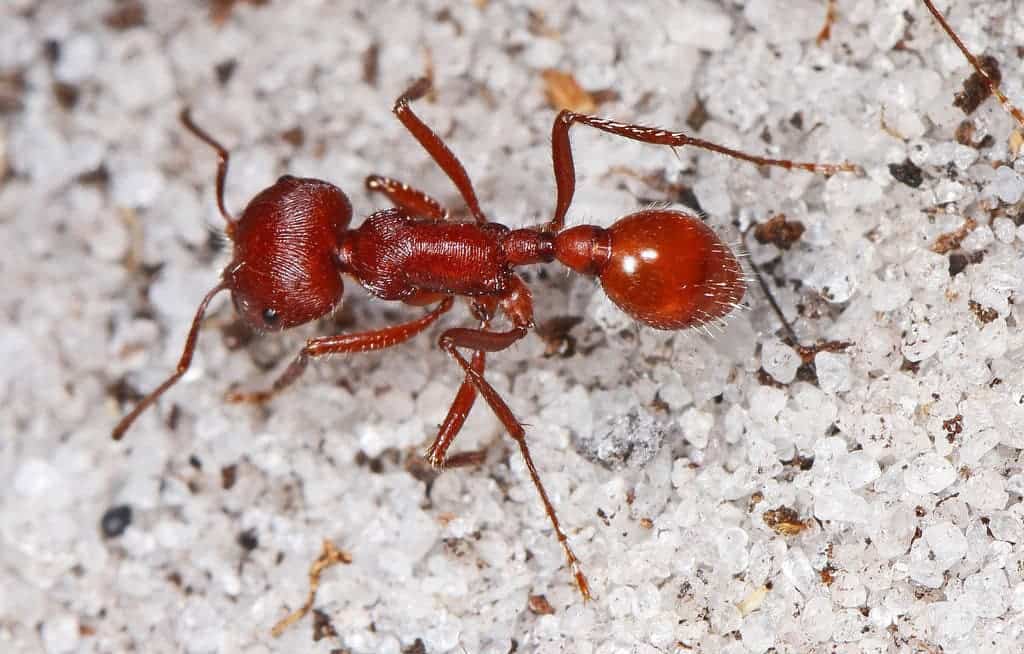Ant colonies don’t organize per se, but they still pull off complex behavior in harsh environments without any glitches. New research looks into how the insects manage this, offering inspiration for future robotic systems.

Image credits Judy Gallagher / Flickr.
Researchers from Princeton have created a new mathematical model to explain how desert harvester ants coordinate efforts to gather seeds. This seemingly-simple process actually needs to be very finely-tuned: in the desert, the colony needs to carefully weigh the water expenditure of foraging against the benefit of bringing in seeds (which serve as both food and water). The model could help future research analyze how ant colonies respond to environmental changes, the team writes, and how behavioral differences among colonies affect their long-term survival and reproductive success.
Anting it
“[The study] was this beautiful marriage of the opportunity not just to collect data, but to define experiments — to use our models and our perspective to try to understand the connection between what individuals are doing and what happens at the level of the group,” said Naomi Ehrich Leonard, Princeton’s Edwin S. Wilsey Professor of Mechanical and Aerospace Engineering, and the paper’s corresponding author.
The study was borne of Professor Leonard’s expertise — she has previously analyzed the dynamics of bird flocks and fish schools to understand how large groups can operate efficiently without central control — and that of Stanford University biologist Deborah Gordon. Gordon and her team have spent the last three decades monitoring red harvester ants (Pogonomyrmex barbatus) at a field site in the New Mexico desert.
Leonard powered-up Gordon’s efforts with a computer model meant to describe how interactions between individual ants generate the complex and highly-tuned behavior seen on the colony-level. In turn, the research will help in the design of robot swarm teams for search and rescue missions or other tasks in environments we can’t reach.
All in all, the ants are an excellent example of how a group of individuals interacts and makes tradeoffs in uncertain conditions. In the dry deserts of the southwestern United States and northern Mexico, red harvester ants gather seeds for both food and water. However, unless they go about it properly, they risk losing more water than they recover from seeds — which would, eventually, lead to the colony dying of dehydration.
“The ants are able to regulate the rate at which they send out foragers with a very limited communication framework,” says Renato Pagliara Vasquez, the study’s lead author.
Vasquez explains that the ants communicate mainly via smell. When two ants tap their antennae together, “they can smell what are called cuticular hydrocarbons, and that smell changes when they’ve been outside the nest. One ant can also tell if the other is carrying a seed, and this information is enough to regulate the entire foraging behavior of the colony.”
The model Leonard developed crunches these interactions to estimate how likely each forager is to leave the nest in search of seeds. Put together, these estimates allow them to analyze how a colony’s foraging rates fluctuate in response to environmental conditions.
To gather data for the model, Gordon’s team used videos and computer-vision software, as well as manual counts, to record 13 colonies of ants. They monitored how many of the insects entered and exited the nests during the morning hours (before it got too hot for the ants to forage) and how these figures varied from colony to colony.
The team looked at foraging behavior as a “closed-loop system” in which the environment and ants that are already foraging outside influence interactions inside the colony. In turn, this affects foraging rates. Ants coming into the colony interact with those already there, influencing their likelihood of engaging in foraging. What they wanted to understand is how environmental conditions affect each ant’s sensitivity to these interactions — something they call “sensitivity level volatility”.
It’s actually very similar to how simple interactions between neurons form our thoughts and memories, the team writes.
“The ants don’t know what the current temperature or humidity is outside the nest, so they become informed the first time they leave the nest,” Vasquez explains. “So, we proposed [that once] they’ve been outside for the first time they change how sensitive they are to interactions with returning foragers. In essence, the colony can use the accumulated information from the incoming ants to regulate how sensitive the colony is to sending out new foragers.”
“This model puts together the interactions of ants inside the nest and the rate at which they forage outside into one system, so that we can understand the process that evolution is shaping,” said Gordon. “Natural selection is acting on how this all works dynamically, and now we have a way to describe that. It’s a very elegant way to think about a lot of noisy dynamics and put it together into a model that can be used to guide further work.”
The researchers plan to expand their research by looking at the behavior of single ants throughout the day. Gordon also plans to integrate the foraging model with genetic data on the ant colonies to explore whether foraging behavior that helps the ants conserve water is heritable, since it is known to affect a colony’s reproductive success.
The paper “Regulation of harvester ant foraging as a closed-loop excitable system” has been published in the journal PLOS Computational Biology.






